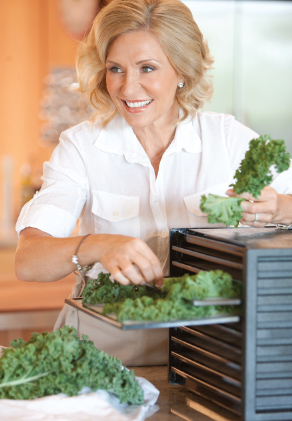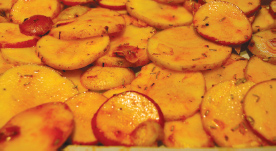Want to get more distance out of your food? Dehydrate it. Food dehydration is a great way to make food last longer, because it’s a natural food preservation practice. Removing water from food prevents certain bacteria from causing that food to go bad. Historically food was dehydrated after the harvest to ensure there would be enough to last through the winter months. The most common foods to dehydrate are fruits, vegetables and meats, but you can also try your hand at drying herbs, fish and even flowers!
The process of dehydrating involves using low heat and constant airflow to suck all of the moisture out of the food without cooking it. Traditionally, dehydration was accomplished by harnessing the powers of the sun and wind. Nowadays kitchen-ready countertop appliances use heat, fans and air vents to dehydrate food quickly, easily and safely.
HOW TO DEHYDRATE:
Sun – only possible if you have 304 days of at least 100°F or build a solar dehydrator
Oven – often removes the flavor of foods, and many ovens can’t go below 200°F, plus you need to prop open the oven door to maintain air circulation
Electric – likely your best option
Why would you choose to dehydrate food? The reasons are endless. Dried food can be stored and used for up to a year, saving you time and money. You’ll be able to use your garden harvest to its full potential rather than having to let some of the foods spoil when you have too much. To this effect, you can take advantage of supermarket specials for buying in bulk, which also saves you money. One of my favorite things about doing your own home dehydration is taking comfort knowing you aren’t eating a host of chemicals from purchased dried or preserved foods. Food drying also happens to be the least harmful to the natural quality of food. In fact, the quality of your food has the potential to increase tenfold. You’ll also have an excellent supply of delicious food in the event of a power outage or weather crisis. Dried food is a popular option to take with you when you are on the go, because it’s light and unbreakable. Think about your typical trail mix. Most of these options are full of dried fruit. Just be sure to check out the preservative and sugar content of store-bought options.
HOW TO DO IT SAFELY:
In order to ensure you are killing any bacteria present in food while dehydrating you must keep the temperature at these indicated levels:
Meats and Fish: 145°F and above
Fruits and Vegetables: 130°F to 140°F
Herbs and flowers: 100°F to 110°F
MOST COMMONLY DEHYDRATED FOODS:
|
Cranberries |
Proscuitto |
|
Apples |
Beef jerky |
|
Pineapple |
Grapes |
|
Bananas |
Prunes |
|
Apricots |
Figs |
|
Cherries |
Dates |
|
kale |
Chili peppers |
|
Tomatoes |
Fruit leathers |

TOSCA PHOTO BY PAUL BUCETA FOOD PHOTOS BY KELSEY-LYNN CORRADETTI
Vegetables:
Green beans: Rinse under cold water. Remove the stems from the top and bottom and snap the beans into 1-inch pieces. Blanch. Dry for 6-12 hours.
Beets: Cook and peel beets to remove their skin. Cut them into ¼-inch pieces. Dry 3-10 hours.
Bell Peppers: Remove seeds and chop. Dry 5-12 hours until leathery.
Broccoli: Rinse, cut and dry 4-10 hours.
Carrots: Rinse, and then peel, slice or shred. Dry 6-12 hours.
Cauliflower: Rinse, cut and dry 6-14 hours.
Corn: Cut corn off cob after blanching and dry 6-12 hours.
Mushrooms: Brush off, don’t wash. Dry at 90 degrees for 3 hours, and then 125 degrees for the remaining drying time. Dry 4-10 hours.
Onions: Slice ¼-inch-thick rounds. Dry 6-12 hours.
Peas: Dry 5-14 hours.
Potatoes: Slice 1/8-inch thick. Dry 6-12 hours until crisp.
Tomatoes: Dip in boiling water to loosen skins. Peel, slice or quarter. Dry 6-12 hours.
Zucchini: Slice 1/8-inch thick and dry 5-10 hours.
Fruit:
Light-colored fruits require a pretreatment with an acidic solution to keep them from darkening, to speed up the process and to ward off bacteria like salmonella.
Apples: Rinse. Peel, core and slice into 3/8-inch rings, or cut into ¼-inch slices. Dry 6-12 hours.
Apricots: Cut in half and turn inside out to dry. Dry 8-20 hours.
Bananas: Peel, cut into ¼-inch slices. Dry 8-16 hours.
Blueberries: Dry 10-20 hours.
Cherries: Cut in half and dry 18-26 hours.
Peaches: Peel, halve or quarter. Dry 6-20 hours.
Pears: Peel, cut into ¼-inch slices. Dry 6-20 hours.
Pineapple: Core and slice ¼-inch thick. Dry 6-16 hours.
Strawberries: Halve or cut into ¼-inch thick slices. Dry 6-16 hours.


DEHYDRATING TIPS:
• Store all dried foods in a cool, dark place like your kitchen cupboards
• Dried foods will last from one season to the next – which means they have a shelf life of about one year
• Don’t worry about flavors mingling together
• You can also use your dehydrator to make your own yogurt and cheese
• Touch the food to see if it is done dehydrating – it will be leathery with no moisture present
• Store your dehydrated foods in airtight containers – as soon as they grab moisture from the air they run the risk of going bad